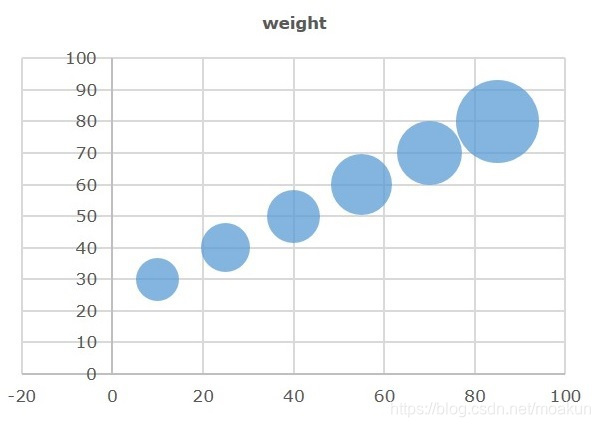翻译自 JavaFX - 气泡图
气泡图用于种植三维数据; 第三个维度将由气泡的大小(半径)表示。
以下是描绘完成工作的气泡图。

在JavaFX中,气泡图由名为BubbleChart的类表示。该类属于包javafx.scene.chart。通过实例化此类,您可以在JavaFX中创建BubbleChart节点。
生成气泡图的步骤
要在JavaFX中生成气泡图,请按照以下步骤操作。
第1步:创建一个类
创建一个Java类并继承包javafx.application的Application类。您可以按如下方式实现此类的start()方法。
public class ClassName extends Application { @Override public void start(Stage primaryStage) throws Exception { } }第2步:定义轴
定义气泡图的X和Y轴并为其设置标签。在我们的例子中,X轴代表年龄,Y轴代表重量。同时,气泡的半径代表完成的工作。
//Defining the X axis
NumberAxis xAxis = new NumberAxis(0, 100, 10);
xAxis.setLabel("Age"); //Defining Y axis
NumberAxis yAxis = new NumberAxis(20, 100, 10);
yAxis.setLabel("Weight");第3步:创建气泡图
通过实例化包javafx.scene.chart的名为BubbleChart的类来创建折线图。对于此类的构造函数,传递表示在上一步中创建的X轴和Y轴的对象。
//Creating the Bubble chart
BubbleChart bubbleChart = new BubbleChart(xAxis, yAxis);第4步:准备数据
实例化XYChart.Series类并将数据(一系列,x和y坐标)添加到此类的Observable列表中,如下所示 -
//Prepare XYChart.Series objects by setting data
XYChart.Series series = new XYChart.Series();
series.setName("work"); series.getData().add(new XYChart.Data(10,30,4));
series.getData().add(new XYChart.Data(25,40,5));
series.getData().add(new XYChart.Data(40,50,9));
series.getData().add(new XYChart.Data(55,60,7));
series.getData().add(new XYChart.Data(70,70,9));
series.getData().add(new XYChart.Data(85,80,6)); 第5步:将数据添加到气泡图
将上一步骤中准备的数据系列添加到面积图中,如下所示 -
//Setting the data to bar chart
bubbleChart.getData().add(series); 第6步:创建组对象
在start()方法中,通过实例化名为Group的类来创建组对象。这属于包javafx.scene。
将在上一步中创建的BubbleChart(节点)对象作为参数传递给Group类的构造函数。这应该是为了将它添加到组中,如下所示 -
Group root = new Group(bubbleChart);第7步:创建场景对象
通过实例化名为Scene的类来创建一个Scene,该类属于包javafx.scene。在此类中,传递在上一步中创建的Group对象(root)。
除了根对象之外,还可以传递两个表示屏幕高度和宽度的双参数,以及Group类的对象,如下所示。
Scene scene = new Scene(group ,600, 300);第8步:设置舞台的标题
您可以使用Stage类的setTitle()方法将标题设置为舞台。所述primaryStage是Stage对象,它被传递给场景类作为参数的启动方法。
使用primaryStage对象,将场景标题设置为Sample Application,如下所示。
primaryStage.setTitle("Sample Application");第9步:将场景添加到舞台
您可以使用名为Stage的类的方法setScene()将Scene对象添加到舞台。使用以下方法添加在前面步骤中准备的Scene对象。
primaryStage.setScene(scene);第10步:显示舞台的内容
显示场景的使用命名的方法的内容显示()的的阶段类,如下所示。
primaryStage.show();第11步:启动应用程序
通过从main方法调用Application类的静态方法launch()来启动JavaFX应用程序,如下所示。
public static void main(String args[]){ launch(args);
}例
让我们考虑不同的人以及他们的年龄,体重和工作能力。工作能力可以视为图表中绘制为气泡的小时数。
| 重量 | ||||||||
|---|---|---|---|---|---|---|---|---|
| 年龄 | ||||||||
| 三十 | 40 | 50 | 60 | 70 | 80 | |||
| 10 | 4 | 工作 | ||||||
| 25 | 五 | |||||||
| 40 | 6 | |||||||
| 55 | 8 | |||||||
| 70 | 9 | |||||||
| 85 | 15 | |||||||
以下是一个Java程序,它生成一个气泡图,使用JavaFX描述上述数据。
将此代码保存在名为BubbleChartExample.java的文件中。
import javafx.application.Application;
import javafx.scene.Group;
import javafx.scene.Scene;
import javafx.scene.chart.BubbleChart;
import javafx.stage.Stage;
import javafx.scene.chart.NumberAxis;
import javafx.scene.chart.XYChart; public class BubbleChartExample extends Application { @Override public void start(Stage stage) { //Defining the axes NumberAxis xAxis = new NumberAxis(0, 100, 10); xAxis.setLabel("Age"); NumberAxis yAxis = new NumberAxis(20, 100, 10); yAxis.setLabel("Weight"); //Creating the Bubble chart BubbleChart bubbleChart = new BubbleChart(xAxis, yAxis); //Prepare XYChart.Series objects by setting data XYChart.Series series = new XYChart.Series(); series.setName("work"); series.getData().add(new XYChart.Data(10,30,4)); series.getData().add(new XYChart.Data(25,40,5)); series.getData().add(new XYChart.Data(40,50,9)); series.getData().add(new XYChart.Data(55,60,7)); series.getData().add(new XYChart.Data(70,70,9)); series.getData().add(new XYChart.Data(85,80,6));//Setting the data to bar chart bubbleChart.getData().add(series); //Creating a Group object Group root = new Group(bubbleChart); //Creating a scene object Scene scene = new Scene(root, 600, 400); //Setting title to the Stage stage.setTitle("Bubble Chart"); //Adding scene to the stage stage.setScene(scene); //Displaying the contents of the stage stage.show(); } public static void main(String args[]){ launch(args); }
}使用以下命令从命令提示符编译并执行保存的java文件。
javac BubbleChartExample.java
java BubbleChartExample执行时,上述程序生成一个显示气泡图的JavaFX窗口,如下所示。





之javafx Chart)




之条形图)



之散点图)



之堆积条形图)

)